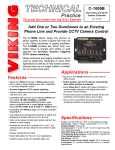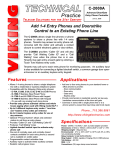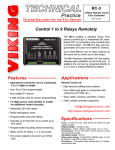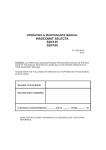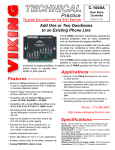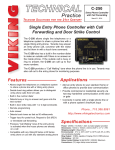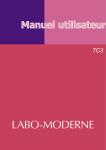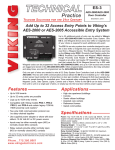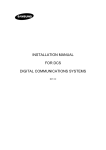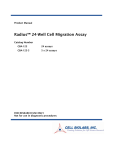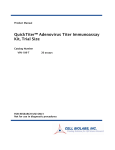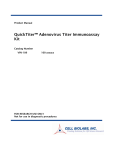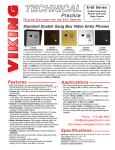Download Viking CTG-2 Product manual
Transcript
Designed, Manufactured and Supported in the USA
VIKING PRODUCT MANUAL
C O M M U N I C AT I O N & S E C U R I T Y S O L U T I O N S
C-500
Advanced Two Door
Entry Phone Controller
with Call Forwarding
January 16, 2014
Advanced Two Door Entry Phone Controller
with Call Forwarding and Door Strike Controls
The C-500 allows single line telephones or a telephone system to share a phone line with two
Viking entry phones. Tenants may answer an entry
phone call, converse with the visitor and let them
in with a touch tone command which activates one
of two relays to control a gate or door strike.
The C-500 also has a built in five number dialer to
call your cell phone or an outside line if there is no
answer on the inside phone. If the outside call is
busy or ring no answer, the C-500 can call up to
four more numbers.
The C-500 provides the house phones with entry
phone “Caller ID” and a “Call Waiting” tone if they
are already on a call. Tenants may also call the
entry phones for monitoring purposes or enter
touch tone commands to activate, deactivate or
toggle the doorsrike/gate control relays.
The C-500 allows up to 6 permanent keyless entry
codes plus 2 “one time use” entry codes for each
door. The C-500 provides optional entry phone distinctive ring, two trigger inputs for “Request to Exit”
and field programmable Caller ID or beep tones
when answered to indicate which door is activated.
Features
Applications
• Allows single line telephones or a telephone system to
share a phone line with two Viking entry phones
• Double and triple distinctive ringing, programmable
entry phone Caller ID or beep tones allow you to distinguish front and back door entry calls from CO calls
• Stackable - connect up to four C-500’s to control up to
eight entry points
• Built in five number dialer (if inside phone doesn’t answer), detects busy or ring no answer and goes on to
the next number
• Provide entry phone activated chimes and whole
house paging when used with an SLP-1 or SLP-4
• Analog Station Dial Through Mode allows entry
phones to connect to analog PABX station or telephone line
• Two N.O./N.C. 5A door strike relays with 1 or 2 digit
activation commands
• Monitor any entry phone by entering a touch tone
• Up to 6 different keyless entry codes, and two “one
time use” keyless entry codes per entrance
• Auto answer for remote programming
• Two trigger inputs for Request to Exit (REX), immediate call forwarding or lighted doorbell switches to activate entry phone calls
• Produces “Call Waiting” tones if the entry phone is activated when the house phones are on a call
• Compatible with the following Viking entry phones:
- E-10A, E-20B, E-30, E-35, E-40, E-50, E-60, E-65,
E-70, and E-75 Phones
- K-1500-7 Stainless Steel Panel Phone
- K-1700-3 and K-1705-3 Phone with Keypad
- K-1900-8 Stainless Steel Panel Phone with Keypad
- Or use with any analog touch tone phone
• Add one or two (expandable to 8) entry phones to your
standard home or office phones to provide:
- Door communication
- Gate Entry
- Door entry
- Keyless Entry
• Provide commercial or residential security via two-way
handsfree communication at the door and gate
• Connects in series with a single phone line or to a
phone system’s unused line input (loop start trunk
input)
• High security building entry systems
• Doorstrikes and gates in conjunction with entry
phones or hot-line/panel phones
www.vikingelectronics.com
Information: (715) 386-8861
Specifications
Power: 120VAC / 13.8VAC 1.25A, UL listed adapter provided
Dimensions: 133mm x 104mm x 44mm (5.25" x 4.1" x
1.75")
Shipping weight: 0.9kg (2 lbs.)
Environmental: 0°C to 32°C (32°F to 90°F) with 5% to
95% non-condensing humidity
Ring Output: 5 REN, capable of ringing (10) 0.5 REN
phones
Talk Battery: 32V DC
Relay Contact Rating: 5A @ 30VDC / 250VAC Maximum
Connections: (19) cage clamp screw terminals
Features Overview
VIKING ©
MODEL C-500
Door Strike 1 LED:
Lights while door strike
1 is activated.
Red Power Indicator LED
6
SLP
CONTROL
DOOR
STRIKE 2
8
9 10 11 12 13 14 15 16 17 18 19
N.C.
7
N.O.
COM
ENTRY
PHONE 2
TRIGGER
INPUT 1
TRIGGER
INPUT 2
DOOR
STRIKE 1
N.C.
ENTRY
PHONE 1
4 5
COM
2 3
Line Out To Phones: Connect to
single or multi-line phones or trunk
input of analog PABX/KSU phone
system.
Entry Phone 1 Input: Connect to a
Viking E-Series or K-Series entry
phone. Note: Standard analog POTS
phone can also be used.
Door Strike 1 Relay Contact
Output: One 5 Amp (N.O./N.C.)
SPDT contact to activate a doorstrike,
magnetic lock or gate controller.
+
ON
1
2
+
C.O./Phone Line Input: Connect to
analog phone line, analog phone
system station port, FXS port, etc.
Note: If installing without a phone
line, “*5” must be programmed.
Door Strike 2 LED:
Lights while door strike
2 is activated.
N.O.
1
LINE OUT
TO PHONES
ADVANCED 2 DOOR ENTRY PHONE
CONTROLLER WITH CALL FORWARDING
PHONE LINE
INPUT
Power Input: 13.8 VAC
@ 1.25A adapter included
POWER 13.8V AC
VIKING
ELECTRONICS
HUDSON, WI 54016
SLP Control Output: Connect to
Viking model SLP-1 or SLP-4 to
provide door chimes over whole
house audio systems. Caution: The
SLP-1 and SLP-4 inputs are polarity
sensitive.
Door Strike 2 Relay Contact
Output: One 5 Amp (N.O./N.C.)
SPDT contact to activate a doorstrike,
magnetic lock or gate controller.
Entry Phone 2 Input: Connect to a
Viking E-Series or K-Series entry
phone. Note: Standard analog POTS
phone can also be used.
Trigger Input 2
Trigger Input 1
Option 1: Connect to a momentary
N.O. Request to Exit (REX) switch to
activate the doorstrike 1 relay (Dip
switch 2 must be OFF and “##3” must
be programmed).
Option 2: Connect to a SPST momentary lighted (6-16V bulb) or non-lighted
doorbell switch. The doorbell switch
will initiate a call from entry phone 1
(Dip switch 2 must be ON).
2
Option 1: Connect to a momentary
N.O. Request to Exit (REX) switch to
activate the doorstrike 1 relay (“##3”
must be programmed).
Option 2: Connect to a Viking model
CTG-1 with CTGF-BKD software to
automatically forward door calls at
specific times during the day or weekends. Note: If calls need to be
forwarded at differing times each day,
a Viking model CTG-2 can be used.
Installation and Applications
A. 1 or 2 Viking E or K Series Entry Phones Sharing a Single Line with Optional Call
Forwarding, Keyless Entry and Doorstrike/Gate Control
VIKING ©
120V AC
MODEL C-500
6
DOOR
STRIKE 2
SLP
CONTROL
8
9 10 11 12 13 14 15 16 17 18 19
N.C.
7
N.O.
COM
ENTRY
PHONE 2
TRIGGER
INPUT 1
TRIGGER
INPUT 2
N.C.
ENTRY
PHONE 1
4 5
COM
2 3
N.O.
1
DOOR
STRIKE 1
ADVANCED 2 DOOR ENTRY PHONE
CONTROLLER WITH CALL FORWARDING
LINE OUT
TO PHONES
13.8V AC
Adapter
included
PHONE LINE
INPUT
POWER 13.8V AC
VIKING
ELECTRONICS
HUDSON, WI 54016
+
5A@30VDC/
250VAC max
120V AC
Entry Phone 2
K-1700-3 shown
(not included,
see DOD# 157)
(Power typically
not required for
gate controllers)
C.O. / Phone
Line Input
Doorstrike /
Magnetic Lock 2
Analog Trunk / Line Input
of a Phone System
120V AC
5A@30VDC/ 250VAC max
(Power typically not required
for gate controllers)
OR
Entry Phone 1
Doorstrike /
Magnetic Lock 1
E-40-SS (not included,
see DOD# 187)
Standard
Analog Phone(s)
B. Connecting up to Four C-500’s to Control up to Eight Viking E or K Series Entry Phones
on a Single CO/Phone Line or Phone System Analog Station Port
1. Connecting to a Single CO/Phone Line (0#63 / Factory Default)
VIKING
2 3
4 5
6
DOOR
STRIKE 2
SLP
CONTROL
ENTRY
PHONE 2
8
9 10 11 12 13 14 15 16 17 18 19
N.C.
7
N.O.
COM
DOOR
STRIKE 1
ENTRY
PHONE 1
POWER 13.8V AC
1
N.C.
+
PHONE LINE
INPUT
9 10 11 12 13 14 15 16 17 18 19
LINE OUT
TO PHONES
DOOR
STRIKE 2
SLP
CONTROL
ENTRY
PHONE 2
8
N.C.
COM
7
COM
6
DOOR
STRIKE 1
ENTRY
PHONE 1
4 5
ADVANCED 2 DOOR ENTRY PHONE
CONTROLLER WITH CALL FORWARDING
N.O.
2 3
N.C.
POWER 13.8V AC
PHONE LINE
INPUT
1
COM
+
MODEL C-500
VIKING
ELECTRONICS
HUDSON, WI 54016
13.8V AC
Adapter
included
ADVANCED 2 DOOR ENTRY PHONE
CONTROLLER WITH CALL FORWARDING
LINE OUT
TO PHONES
DOOR
STRIKE 2
SLP
CONTROL
9 10 11 12 13 14 15 16 17 18 19
N.C.
8
N.O.
COM
INPUT 2
TRIGGER
INPUT 1
TRIGGER
7
13.8V AC
Adapter
included
N.O.
6
DOOR
STRIKE 1
ENTRY
PHONE 1
4 5
N.C.
2 3
COM
POWER 13.8V AC
1
N.O.
+
LINE OUT
TO PHONES
9 10 11 12 13 14 15 16 17 18 19
VIKING ©
ELECTRONICS
HUDSON, WI 54016
ADVANCED 2 DOOR ENTRY PHONE
CONTROLLER WITH CALL FORWARDING
PHONE LINE
INPUT
DOOR
STRIKE 2
SLP
CONTROL
INPUT 2
ENTRY
PHONE 2
8
N.C.
COM
7
N.O.
POWER 13.8V AC
DOOR
STRIKE 1
TRIGGER
INPUT 1
TRIGGER
N.C.
6
COM
4 5
N.O.
ENTRY
PHONE 1
PHONE LINE
INPUT
LINE OUT
TO PHONES
2 3
(Program: 1#60, 7#48, 8#49)
120V AC
MODEL C-500
VIKING
ADVANCED 2 DOOR ENTRY PHONE
CONTROLLER WITH CALL FORWARDING
1
VIKING ©
ELECTRONICS
HUDSON, WI 54016
13.8V AC
Adapter
included
Secondary Unit 4
(Program: 1#60, 5#48, 6#49)
120V AC
N.O.
VIKING
MODEL C-500
INPUT 2
VIKING ©
ELECTRONICS
HUDSON, WI 54016
13.8V AC
Adapter
included
Secondary Unit 3
(Program: 1#60, 3#48, 4#49)
120V AC
TRIGGER
INPUT 1
TRIGGER
INPUT 2
Secondary Unit 2
MODEL C-500
ENTRY
PHONE 2
VIKING ©
TRIGGER
INPUT 1
TRIGGER
Primary Unit 1
(Program: 0#60, 1#48, 2#49)
120V AC
+
Analog Trunk / Line Input
of a Phone System
C.O. / Phone
Line Input
Entry Phone 8
K-1700-3 shown
(DOD# 157)
OR
Entry Phone 1
E-40-SS shown
(DOD# 187)
Entry Phone 2
E-50-BN shown
(DOD# 191)
Entry Phone 3
E-60-WH shown
(DOD# 206)
Entry Phone 4
E-65-BK shown
(DOD# 203)
Entry Phone 5
E-70-PB shown
(DOD# 207)
Entry Phone 6
E-75-SS shown
(DOD# 208)
Standard
Analog Phone(s)
Entry Phone 7
K-1705-3-BN shown
(DOD# 157)
3
2. Connecting to a Single Phone System Analog Station Port (1#63 / Analog Station Mode Enabled)
Note: When connected to an entry phone, “Activate All” commands will only activate the two door strike relays
on the C-500 you are communicating with.
1
2 3
6
DOOR
STRIKE 2
SLP
CONTROL
ENTRY
PHONE 2
DOOR
STRIKE 1
7
8
9 10 11 12 13 14 15 16 17 18 19
N.C.
ENTRY
PHONE 1
4 5
N.C.
POWER 13.8V AC
+
PHONE LINE
INPUT
9 10 11 12 13 14 15 16 17 18 19
LINE OUT
TO PHONES
DOOR
STRIKE 2
SLP
CONTROL
INPUT 2
ENTRY
PHONE 2
8
N.C.
7
COM
6
COM
DOOR
STRIKE 1
ENTRY
PHONE 1
4 5
ADVANCED 2 DOOR ENTRY PHONE
CONTROLLER WITH CALL FORWARDING
N.O.
2 3
N.C.
1
COM
PHONE LINE
INPUT
POWER 13.8V AC
+
ADVANCED 2 DOOR ENTRY PHONE
CONTROLLER WITH CALL FORWARDING
LINE OUT
TO PHONES
DOOR
STRIKE 2
SLP
CONTROL
INPUT 2
ENTRY
PHONE 2
9 10 11 12 13 14 15 16 17 18 19
N.C.
COM
8
N.O.
7
MODEL C-500
VIKING
ELECTRONICS
HUDSON, WI 54016
13.8V AC
Adapter
included
N.O.
6
DOOR
STRIKE 1
ENTRY
PHONE 1
4 5
N.C.
2 3
COM
1
VIKING ©
VIKING
N.O.
POWER 13.8V AC
+
PHONE LINE
INPUT
9 10 11 12 13 14 15 16 17 18 19
(Program: 0#60, 1#63, 1#48, 2#49)
120V AC
ELECTRONICS
HUDSON, WI 54016
13.8V AC
Adapter
included
ADVANCED 2 DOOR ENTRY PHONE
CONTROLLER WITH CALL FORWARDING
LINE OUT
TO PHONES
DOOR
STRIKE 2
SLP
CONTROL
ENTRY
PHONE 2
8
N.C.
COM
7
N.O.
POWER 13.8V AC
DOOR
STRIKE 1
TRIGGER
INPUT 1
TRIGGER
INPUT 2
N.C.
6
COM
4 5
N.O.
ENTRY
PHONE 1
PHONE LINE
INPUT
LINE OUT
TO PHONES
2 3
Primary Unit 1
MODEL C-500
COM
VIKING
ELECTRONICS
HUDSON, WI 54016
13.8V AC
Adapter
included
ADVANCED 2 DOOR ENTRY PHONE
CONTROLLER WITH CALL FORWARDING
1
VIKING ©
N.O.
VIKING
ELECTRONICS
HUDSON, WI 54016
13.8V AC
Adapter
included
Seconday Unit 2
(Program: 1#60, 1#63, 3#48, 4#49)
120V AC
MODEL C-500
N.O.
VIKING ©
TRIGGER
INPUT 1
TRIGGER
INPUT 2
Seconday Unit 3
(Program: 1#60, 1#63, 5#48, 6#49)
120V AC
MODEL C-500
TRIGGER
INPUT 1
TRIGGER
VIKING ©
TRIGGER
INPUT 1
TRIGGER
Seconday Unit 4
(Program: 1#60, 1#63, 7#48, 8#49)
120V AC
+
Analog Station
Port on a
Phone System
(PABX/KSU)
Entry Phone 7
E-40-SS shown
(DOD# 187)
Entry Phone 8
E-50-BN shown
(DOD# 191)
Entry Phone 5
Entry Phone 6
E-60-WH shown E-65-BK shown
(DOD# 206)
(DOD# 203)
Entry Phone 3
E-70-PB shown
(DOD# 207)
Entry Phone 4
E-75-SS shown
(DOD# 208)
Entry Phone 1
Entry Phone 2
K-1700-3 shown K-1705-3-BN shown
(DOD# 157)
(DOD# 157)
C. Provide Paging with Four Different CD Quality Door Chimes and Control of up to Four Entry
Phones and Doorstrikes from a Single Phone Line with the Viking SLP-4 and Two C-500’s
The SLP-4 can be used with one or two Viking C-500 entry phone controllers. The phone line first runs through
the SLP-4, then runs through one or two C-500’s before continuing on to the house phones. Connect both C500’s “SLP Control” output terminals 18 & 19 to the SLP-4’s trigger input (CAUTION: This connection is polarity
sensitive.) When entry phone 1, 2, 3, or 4 call in, the SLP-4 will play its dip switch selected door chime. To provide
up to 4 different door chimes, the SLP-4’s “Doorbell Mode” dip switch must be turned ON. The C-500’s entry
phone ringing can be disabled be entering 0#62 in programming. IMPORTANT: See the SLP-4 Product Manual
for complete programming instructions (DOD# 479).
Model SLP-4 (not included,
see DOD# 479 for more info)
MODEL SLP-4
TRIGGERED AUDIO
PLAYBACK VOLUME
POWER
MSG
GND
C.O. /
Phone Line
CO LINE
INPUT
OUT TO
PHONES
USB
TRIG 1
+
MSG
MSG
MSG
TRIG 2
TRIG 3
TRIG 4
LOUD
RING
+
IO COM
PAGE
MUTE
AUDIO
2 3
4 5
6
1
2 3
4 5
6
DOOR
STRIKE 2
SLP
CONTROL
8
9 10 11 12 13 14 15 16 17 18 19
N.C.
7
N.O.
COM
ENTRY
PHONE 2
TRIGGER
INPUT 1
TRIGGER
INPUT 2
DOOR
STRIKE 1
POWER 13.8V AC
+
ENTRY
PHONE 1
9 10 11 12 13 14 15 16 17 18 19
LINE OUT
TO PHONES
8
PHONE LINE
INPUT
DOOR
STRIKE 2
SLP
CONTROL
ENTRY
PHONE 2
7
N.C.
1
COM
+
TRIGGER
INPUT 1
TRIGGER
INPUT 2
DRY
WET
12VDC
POWER MUTE AUDIO PAGE
ADVANCED 2 DOOR ENTRY PHONE
CONTROLLER WITH CALL FORWARDING
N.O.
4
N.C.
3
ADVANCED 2 DOOR ENTRY PHONE
CONTROLLER WITH CALL FORWARDING
COM
2
MODEL C-500
VIKING
ELECTRONICS
HUDSON, WI 54016
N.O.
1
VIKING ©
MODEL C-500
VIKING
ELECTRONICS
HUDSON, WI 54016
N.C.
WAVE
FILE
INPUT
USB
COM
USB
LED
N.O.
MUSIC ON
HOLD INPUT
PAGE TRIGGER
OUTPUT
DOORBELL MODE
ON HOLD ALARM
DIAL "9"
N.C.
TRIGGERED AUDIO
CHIME/MESSAGE SELECTIONS
PER TRIGGER INPUT
VIKING ©
DOOR
STRIKE 1
2 WATT
AMP GAIN
ENTRY
PHONE 1
LOUD RINGING
VOLUME
Optional Seconday Unit
(Program: 1#60, 3#48, 4#49)
COM
POWER
13.8 VAC
Primary Unit
(Program: 0#60, 1#48, 2#49)
N.O.
PAGE
VOLUME
SINGLE LINE PAGING CONTROLLER
WITH FOUR RECORDABLE
TRIGGERED AUDIO CHIMES / MESSAGES
POWER 13.8V AC
VIKING
ELECTRONICS
HUDSON, WI 54016
LINE OUT
TO PHONES
©
PHONE LINE
INPUT
VIKING
+
PAGE
+ SPK OUTPUT
-
+
-
+
-
To Additional
Standard
Analog Phones
*DIP Switch 1
must be ON
4
To "Page" input on
your whole house
audio controller.
Standard
Analog Phone
D. Provide Whole House Paging, Control Up to 2 Entry Phones and Doorstrikes and Provide
Entry Phone Triggered Unique Front and Back Door Chimes from a Single Line Phone
The SLP-1 can be used with one Viking C-500 entry phone controller. The phone line first runs through the SLP1, then runs through the C-500 before continuing on to the house phones. Connect the C-500 “SLP Control” output
terminals 18 & 19 to the SLP-1’s “Doorbell Sw Input” input (CAUTION: This connection is polarity sensitive.) When
entry phones 1 or 2 call in, the SLP-1 will play its dip switch selected door chime.
1
2 3
4 5
DOOR
STRIKE 2
SLP
CONTROL
ENTRY
PHONE 2
8
9 10 11 12 13 14 15 16 17 18 19
N.C.
COM
DOOR
STRIKE 1
7
6
N.O.
AUDIO
OUTPUT
L
R
R
N.C.
AUDIO
INPUT
L
ENTRY
PHONE 1
MUSIC
ON
HOLD
INPUT
ADVANCED 2 DOOR ENTRY PHONE
CONTROLLER WITH CALL FORWARDING
COM
13.8V AC
Adapter
included
MAX
MIN
SINGLE LINE
PAGING CONTROLLER
N.O.
MAX
MIN
MODEL C-500
VIKING
ELECTRONICS
HUDSON, WI 54016
120V AC
TRIGGER
INPUT 1
TRIGGER
INPUT 2
2 WATT
AMP GAIN
POWER 13.8V AC
POWER 13.8 VAC
13.8V AC
Adapter
included
VIKING ©
MODEL SLP-1
VIKING
ELECTRONICS
HUDSON, WI 54016
LINE OUT
TO PHONES
PREAMP
VOLUME
PHONE LINE
INPUT
VIKING ©
120V AC
+
ON
+
-
+
DOOR BELL LOUD RING
+ PAGE
TRIG. OUT
SW. INPUT ENABLE I.O. COM.
PWR
1
PAGE
2
3
MUTE
+
C.O. /
Phone Line
C.O. LINE
INPUT
OUT TO
PHONES
- SPKR +
OUTPUT
L
R
L
R
ON
OFF
To "Page" input
on your whole house
audio controller
1
2
3
To Doorstrike/Magnetic Lock
To Doorstrike/
Magnetic Lock
DIP switch 2 must
be ON (see below)
To Standard Analog Phones
or Viking Entry Phones
models: E-10A, E-20B, E-30,
E-40, E-50, E-60,K-1500-7,
K-1700-3 or K-1900-8.
Music On Hold
Source (Radio)
To Optional Speakers
or Paging Horns
-
ON
1/8" (3mm) Double Ended
Audio Cord (included)
Standard
Analog
Phone
To Additional Standard
Analog Phones
E. Using the C-500 with the CTG-1, CTG-2 or a Toggle Switch for Immediate Call Forwarding at
Certain Hours of the Day
VIKING ©
Model CTG-1 (DOD# 460) with CTGF-BKD Software
or Model CTG-2 (DOD# 463)
MODEL C-500
VIKING ©
VIKING
MODEL CTG-1
6
DOOR
STRIKE 2
SLP
CONTROL
ENTRY
PHONE 2
8
9 10 11 12 13 14 15 16 17 18 19
N.C.
7
N.O.
COM
DOOR
STRIKE 1
TRIGGER
INPUT 1
TRIGGER
INPUT 2
N.C.
ENTRY
PHONE 1
4 5
COM
2 3
-
CLOCK CONTROLLED
TONE GENERATOR
PM
TIME
MODE
+
/ CANCEL
LOCK
SET TIME
SET DAY
ALERT TONES
N.O.
1
LINE OUT
TO PHONES
PHONE LINE
INPUT
POWER 13.8V AC
ELECTRONICS
HUDSON, WI 54016
ADVANCED 2 DOOR ENTRY PHONE
CONTROLLER WITH CALL FORWARDING
+
SINGLE
DOUBLE
TRIPLE
SET EVENTS
REVIEW/CANCEL
VOL 1 2 3 4 5 6 7 8 9 10 11 12
9V BATTERY
BACKUP
OR
F. Using the C-500 with a Proximity Card Reader or a Separate Keyless Entry Keypad
Step 1 Program the ES-1 “Relay Activation Time” to match the “Doorstrike Activation Time” on the C-500.
Step 2 Connect the ES-1 relay output in parallel with the doorstrike output contacts on the C-500.
MODEL C-500
VIKING ©
6
STAND-ALONE
DOOR CONTROLLER
ENTRY SYSTEM
ENTRY POINT
PROGRAM
PHONE
5A@30VDC/
250VAC
maximum
(Power typically
not required for
gate controllers)
Doorstrike/
Magnetic Lock
Viking PRX-1 Proximity Card Reader
(shown, not included, DOD# 221)
OR
Viking PRX-2 Card Reader/Keypad (DOD# 219)
Viking PRX-3 Card Reader (DOD# 228)
Viking PRX-4 Keypad (DOD# 199)
WHT
WIEGAND
DEVICE
GRN
GANG
LOG PROG
BUS COMM
+
BLK
9 10 11 12 13 14 15 16 17 18 19
POWER 12 VDC
SLP
CONTROL
DOOR
STRIKE 2
8
N.C.
7
N.O.
COM
ENTRY
PHONE 2
TRIGGER
INPUT 1
TRIGGER
INPUT 2
DOOR
STRIKE 1
N.C.
4 5
COM
ENTRY
PHONE 1
LINE OUT
TO PHONES
2 3
N.O.
1
MODEL ES-1
VIKING
ELECTRONICS
HUDSON, WI 54016
ADVANCED 2 DOOR ENTRY PHONE
CONTROLLER WITH CALL FORWARDING
PHONE LINE
INPUT
POWER 13.8V AC
VIKING
ELECTRONICS
HUDSON, WI 54016
RED
VIKING ©
Viking E-70 Entry Phone
(shown, not included, DOD# 207)
OR
Viking E-75 Entry Phone
(not included, DOD# 208)
and/or
5
G. Using the C-500 Without a C.O. Line
120V AC
VIKING ©
6
DOOR
STRIKE 2
SLP
CONTROL
ENTRY
PHONE 2
9 10 11 12 13 14 15 16 17 18 19
Access programming as shown in ProgramStep 3 ming section A, 2. below. Enter Q5, two
beeps should be heard.
N.C.
8
N.O.
7
Connect an analog phone or unused phone
system (PABX/KSU) line /trunk port to terminals 3 & 4, “LINE OUT TO PHONES” on the
C-500.
COM
DOOR
STRIKE 1
TRIGGER
INPUT 1
TRIGGER
INPUT 2
ENTRY
PHONE 1
4 5
N.C.
2 3
COM
1
N.O.
POWER 13.8V AC
ADVANCED 2 DOOR ENTRY PHONE
CONTROLLER WITH CALL FORWARDING
LINE OUT
TO PHONES
13.8V AC
Adapter
included
Connect the power, required entry phones
Step 1 and doorstrike outputs (if required) as
shown in section A.
Step 2
MODEL C-500
VIKING
ELECTRONICS
HUDSON, WI 54016
PHONE LINE
INPUT
The C-500 can also be used without a C.O. line. This is
ideal for connecting the C-500 to an unused trunk/line
input of your phone system of connecting to phones
used only for doorbox communication.
+
Unused Line /
Standard Trunk Input on
Analog Phone System
(PABX/KSU)
Phones
Enter additional desired programming, then
Step 4 hang-up the phone and place DIP switch 1
back to the OFF position.
or
Accessing Programming
1. Accessing the Programming Mode with a Security Code
Step 1 Come off-hook with any house phone (device) connected to terminals 3 & 4, LINE OUT TO PHONES.
Step 2
Enter Q# followed by the 6-digit security code (factory set to 845464, V-I-K-I-N-G, see Quick Programming Features page 7).
Step 3 A double beep will indicate that you have accessed the programming mode.
Step 4 You can now touch tone program the features listed in Quick Programming Features page 7.
Step 5 When finished programming, hang up.
2. Accessing the Programming Mode Locally (Security Code Bypass Mode)
Note: This mode is useful if you have forgotten your security code or for programming the C-500 without a telephone line connected.
Step 1 Move DIP switch 1 to ON (Security Code Bypass Mode, see DIP Switch Programming page 11).
Step 2 Come off-hook with any house phone connected to terminals 3 & 4, LINE OUT TO PHONES.
Step 3 A double beep will indicate that you have accessed the programming mode.
Step 4 You can now touch tone program the features listed in Quick Programming Features page 7.
Step 5 When finished programming, hang up and move DIP switch 1 to the OFF position.
3. Accessing the Programming Mode Remotely
Step 1
Call into the C-2000B from a touch tone phone. Note: Call in from another line to avoid C.O. busy signals,etc.
Step 2 Answer the call from any house phone (device) connected to terminals 3 & 4, LINE OUT TO PHONES.
Step 3
From either phone enter Q# followed by the six digit security code (factory set to 845464, see Quick
Programming Features page 7.).
Step 4 A double beep will indicate that you have accessed the programming mode.
Step 5 You can now touch tone program the features listed in Quick Programming Features page 7.
Note: Programming from a cell-phone may not be suitable in areas with weak coverage.
6
Quick Programming Features (after accessing the Programming Mode)
Description
Enter Digits
Entry phone 1 first call forward number ..................................................................... 1-20 digits (0-9)
Entry phone 1 second call forward number ................................................................ 1-20 digits (0-9)
Entry phone 1 third call forward number .................................................................... 1-20 digits (0-9)
Entry phone 1 fourth call forward number .................................................................. 1-20 digits (0-9)
Entry phone 1 fifth call forward number ..................................................................... 1-20 digits (0-9)
Entry phone 2 first call forward number ..................................................................... 1-20 digits (0-9)
Entry phone 2 second call forward number ................................................................ 1-20 digits (0-9)
Entry phone 2 third call forward number .................................................................... 1-20 digits (0-9)
Entry phone 2 fourth call forward number .................................................................. 1-20 digits (0-9)
Entry phone 2 fifth call forward number ..................................................................... 1-20 digits (0-9)
To clear any call forward speed dial number .............................................................. (no digits)
Privacy number (factory disabled) .............................................................................. 0-6 digits (0-9)
Entry phone 1 keyless entry codes (factory disabled) ................................................ 4-6 digits (0-9)
Entry phone 1 keyless toggle entry code (factory disabled) ...................................... 4-6 digits (0-9)
Entry phone 1 keyless one time use codes (factory disabled) ................................... 4-6 digits (0-9)
Entry phone 2 keyless entry codes (factory disabled) ................................................ 4-6 digits (0-9)
Entry phone 2 keyless toggle entry code (factory disabled) ...................................... 4-6 digits (0-9)
Entry phone 2 keyless one time use codes (factory disabled) ................................... 4-6 digits (0-9)
+
+
+
+
+
+
+
+
+
+
+
+
+
+
+
+
+
+
+
Entry phone 1 caller ID (factory set to “Entry Phone 1”) .... 0-15 two digit characters (see section 5, pg 8)
Entry phone 2 caller ID (factory set to “Entry Phone 2”) .... 0-15 two digit characters (see section 5, pg 8)
+ #30
+ #31
Door strike command (QQ = Q, QQQQ = QQ, 0-9 or 00-99, factory set to QQ) ................. 1 or 2 digits
Relay activation tone (buzz) volume (0 = off, 3 = maximum, factory set to 2) ................... 0 - 3
Door strike 1 activation time (00 = .5 sec, factory set to 5 sec) ......................................... 00 - 99 sec
Door strike 2 activation time (00 = .5 sec, factory set to 5 sec) ......................................... 00 - 99 sec
Call forward maximum call time (0 = 30 sec, blank = disable, factory set to 3 mins) ......... 1 - 9 mins
Call forward maximum ring time (00 = disabled, factory set to 30 sec) ............................. 01 - 59 sec
Maximum ring count from entry phone before call forward (0=immediate call forward,
1-9
factory set to 4) ..................................................................................................................
Incoming ring count before auto answer (00 = disables auto answer, factory set to 10) ............. 01 - 99
Security code (factory set to 845464) ................................................................................ 6 digits
+
+
+
+
+
+
+
Single entry dual door strike mode (factory disabled/blank, 00 = no delay, 01-99 sec) ..............
Entry phone 1 identifier (factory set to 1) ....................................................................................
Entry phone 2 identifier (factory set to 2) ....................................................................................
Multiple Unit setting (0 = Primary, 1 = Secondary, factory set to 0) ............................................
Enable/disable Immediate Call Forward command (0 = disable, 1 = enable, factory set 1) .......
Enable/disable Entry phone ringing (0 = disable, 1 = enable, factory set to 1) ...........................
Analog Station Mode (0 = disable, 1 = enable, factory set to 0) .................................................
Flash required before outgoing off-hook operation commands (0=disable, 1=enable/factory set) .......
Entry phone chime control mode (0 = disable, 1 = enable, factory set to 0) ...............................
+
+
+
+
+
+
+
+
+
00 - 99
1-8
1-8
0 or 1
0 or 1
0 or 1
0 or 1
0 or 1
0 or 1
Description
Enable door strike latching and toggle commands (factory setting) .......................................................
Disable door strike latching and toggle commands ................................................................................
Entry phone calls give custom ring cadence (factory setting) .................................................................
Entry phone calls give standard ring cadence (2 sec on, 4 sec off) .......................................................
Dial “9” to access an outside line (gives single beep on off hook to remind user) ..................................
Instant outside line access (factory setting) ............................................................................................
To add a 4 - 6 sec pause anywhere in the dialing string .........................................................................
To add a 1 sec pause anywhere in the dialing string ..............................................................................
Enable Entry phone identifier beeps (factory setting) .............................................................................
Disable Entry phone identifier beeps ......................................................................................................
To add a “Q” to dialing string, privacy number, keyless code or strike command ...................................
To add a “#” to dialing string ...................................................................................................................
Ignore touch tones for programming Entry phone 1 ...............................................................................
Ignore touch tones for programming Entry phone 2 ...............................................................................
Trigger inputs activate door strike relays (factory setting) ......................................................................
Trigger input 2 enables call forwarding when triggered ..........................................................................
Comcast mode ON (Note: Should only be programmed on the first unit in multi unit applications) .......
Comcast mode OFF (factory setting) ......................................................................................................
Exit programming ....................................................................................................................................
Reset all programming to factory default settings ...................................................................................
Location
#00
#01
#02
#03
#04
#05
#06
#07
#08
#09
#00-#09
#10
#11-#16
#17
#18-#19
#21-#26
#27
#28-#29
#32
#33
#40
#41
#42
#43
#44
+ #45
+ #47
#46
#48
#49
#60
#61
#62
#63
#64
#65
Enter Digits
Q1
Q2
Q3
Q4
Q5
Q6
Q7
Q8
Q9
Q0
QQ
Q#
##1
##2
##3
##4
##5
##6
##7
7
###
Programming Features
1. Call Forwarding Speed Dial Numbers (#00 – 09)
The call forwarding speed dial number stored in location #00 is the first outside number that will be dialed if entry
phone 1 goes off hook and the house phone does not answer within the ring count set by programming location
#44. Additional speed dial numbers will be dialed if there is no answer or a busy at the first number. Each number
is called only once. If all numbers are called without an answer, the C-500 will generate a CPC signal and then a
busy signal will be sent to the door phone. To clear a speed dial number position, simply enter a # and the location
number (00 to 09), without any preceding numbers. If no numbers are programmed, the C-500 will only call the
house phone. To program a 4 to 6 second pause in the dialing string enter “Q7”. To program a 1 second pause
enter “Q8”. To program a Q or # in the dialing string enter “QQ” or “##”. Note: Up to 20 digits can be stored in each
dial position. Special features such as one and four to six second pauses, and touch tone * and # count as a
single digit.
2. Privacy Number (#10)
The “Privacy Number” is factory disabled so an entry phone off-hook will automatically ring the house phones. If
a “Privacy Number” is programmed, the visitor must touch tone dial the number to be able to call into the house.
The “Privacy Number” may be from 1 to 6 digits and is stored in location “#10”. To disable the “Privacy Number,”
clear the number’s memory location by entering “#10” without any previous digits.
3. Keyless Entry Codes and One Time Use Keyless Entry Codes (#11-16, #18-19, #21-26, #28-29)
Each entry phone may have a combination of up to 6 keyless entry codes and 2 one time use keyless entry codes
for touch tone keyless entry. The keyless entry codes may be from 4 to 6 digits in length and are stored in locations
#11 - #16 for entry phone 1 and #21- #26 for entry phone 2. To clear any keyless entry codes, simply enter the location number (ie: “#11”) without any previous digits.
4. Keyless Toggle Entry Code (#17, #27)
Each entry phone may have 1 keyless toggle entry code for toggling the door strike relay on or off. The toggle
codes may be from 4 to 6 digits in length and are stored in location #17 for entry phone 1 and #27 for entry phone
2. To clear any toggle codes, simply enter the location number (ie: “#17”) without any previous digits.
5. Entry Phone Caller ID (#30, #31)
The C-500 is factory set to send “Entry Phone 1” or “Entry Phone 2” Caller ID data to the house phones when
the corresponding entry phone is activated. The entry phone caller ID is programmable by entering a string of up
to 15 two digit numbers into programming location #30 for entry phone 1 and #31 for entry phone 2. Use the chart
below to enter the two digit number that represents the character to be programmed. To disable Caller ID simply
enter the programming location number #30 and #31 without any previous digits.
Entry Phone 1 CID Characters:
___ ___ ___ ___ ___ ___
___
___
___
___
___
___
___
___
___
Two Digit Numbers:
__ __ __ __ __ __ __ __ __ __ __ __ __ __ __ __ __ __ __ __ __ __ __ __ __ __ __ __ __ __ #30
Entry Phone 2 CID Characters:
___ ___ ___ ___ ___ ___
___
___
___
___
___
___
___
___
___
Two Digit Numbers:
__ __ __ __ __ __ __ __ __ __ __ __ __ __ __ __ __ __ __ __ __ __ __ __ __ __ __ __ __ __ #31
Caller ID Programming Chart
8
2 Digit
Number
00
01
02
03
04
05
06
07
08
09
10
11
12
13
14
15
16
17
18
Character
(space)
!
“
#
$
%
&
‘
(
)
*
+
,
.
/
0
1
2
2 Digit
Number
19
20
21
22
23
24
25
26
27
28
29
30
31
32
33
34
35
36
37
Character
3
4
5
6
7
8
9
:
;
<
=
>
?
@
A
B
C
D
E
2 Digit
Number
38
39
40
41
42
43
44
45
46
47
48
49
50
51
52
53
54
55
56
Character
F
G
H
I
J
K
L
M
N
O
P
Q
R
S
T
U
V
W
X
2 Digit
Number
57
58
59
60
61
62
63
64
65
66
67
68
69
70
71
72
73
74
75
Character
Y
Z
[
\
]
^
_
`
a
b
c
d
e
f
g
h
i
j
k
2 Digit
Number
76
77
78
79
80
81
82
83
84
85
86
87
88
89
90
91
92
93
94
Character
l
m
n
o
p
q
r
s
t
u
v
w
x
y
z
{
|
}
~
6. Door Strike Command (#32)
The one or two digit code stored in the Door Strike Command is the touch tone command that the person being
called must enter on their touch tone phone in order to actuate the door strike. The code can contain the numbers
1 to 9, 0, Q, # or any two digit combinations. To disable this feature enter #32 without any preceding digits. The
code must be entered while the house phone or the remote phone is connected to the door phone.
The C-500 determines which direction the touch tone is coming from and only responds to touch tones from the
called phone. Because of this, single digit codes must be a minimum of 100 msec in duration. Some cell phones
can only produce fast touch tones (< 100 msec). If using one of these phones, program a two digit Door Strike
Command. When two digits are programmed, the entry phone will be dropped after the first digit, so the C-500
can be sure the second digit is coming from the called phone. With a two digit code, the minimum duration of the
tones can be as low as 50msec. The factory setting is “QQ”.
7. Relay Activation Tone (Buzz) Volume (#33)
The relay activation tone is a buzzing sound that is heard on the entry phone when the door strike relay is activated.
The tone length will match the door strike activation time up to a maximum of 5 seconds. The tone can be programmed to three different volume setting 1 = Low, 2= Medium, 3 = High in memory location #33. The tone can
also be disabled by entering 0#33.
8. Door Strike Activation Time (#40, #41)
The value stored in the Door Strike Activation Time is the amount of time the door strike relay will be energized
after a correct touch tone command is entered or the trigger input is activated. This two digit number can range
from 01 to 99 seconds, or enter 00 for 0.5 seconds. The factory setting is 5 seconds.
9. Call Forward Maximum Call Time (#42)
The Call Forward Max Call Time can be used to cut off a call that has rolled over to an outside number. The timer
starts as soon as the C-500 is done dialing each number. If the call lasts longer than the time programmed, the
phone line will be dropped and a busy signal will be sent to the entry phone. This is useful if a standard telephone
is being used for an entry phone and the handset is accidentally left off hook. This one digit number can range
from 1 to 9 minutes or enter 0 for 30 seconds. To disable this feature enter #42 without any preceding digits. The
factory setting is 3 minutes.
10. Call Forward Maximum Ring Time (#43)
After the C-500 dials an outside number, it listens to the phone line for busy, ringing, or someone answering at
the other end. The Call Forward Max Ring Time is used to limit this process in the event that the C-500 cannot
determine if the call has been answered. If the C-500 cannot determine that the call has been answered within
the “Call Forward Max Ring Time”, the line will be disconnected and the C-500 will go onto the next speed dial
number. This two digit number can range from 01 to 59 seconds and can be disabled by entering #43 without any
preceding digits. As a general rule, allow 6 seconds for each ring you desire at the distant phone. The factory setting is 30 seconds or about 5 rings.
11. Maximum Ring Count from Entry Phone before Call Forward (#44)
When the entry phone comes off hook, the C-500 will start ringing the house phone. The number of times the
house phone will ring is stored in location #44. This value can range from 1 to 9, if blank or 0 is entered, the C500 will skip ringing the house phone and immediately start calling the programmed phone numbers. This feature
is useful when the user is not at home and they want the fastest connect time to their cell phone. There is also an
operational command of “QQQ” (see Operation section B) and a trigger input (see Operation section B) that can
be used for immediate call forwarding. The factory setting is 4.
12. Incoming Ring Count (#45)
The 2 digit number in this location determines how many times a call coming in from the phone line will ring the
house phones before the C-500 answers the call. This number can range from 01 to 99, if blank or 00, the Auto
Answer feature of the C-500 will be disabled. The factory setting is 10.
13. Security Code (#47)
The security code must be 6 digits long and cannot contain a “Q” or “#”. The factory default code is “845464” and
can be changed in programming by entering 6 digits followed by “#47”.
14. Single Entry Dual Door Strike Mode (#46)
The C-500 can be programmed to activate both of its door strike relays simultaneously or with a programmable
delay before the second door strike relay is activated. This can be useful in larger entryways with both outside
and inside locked doors. A delay can be programmed allowing the guest enough time to get to the second door
before activating the second door strike. On incoming entry phone calls, when the user enters the door strike
command, door strike relay 1 will activate first then after the programmed delay, door strike relay 2 will activate.
In this application, if a request for exit switch is used it should be connected to the trigger 2 input. When the
request for exit switch is activated, door strike relay 2 will activate first then after the programmed delay, door
strike relay 1 will activate. The delay can be programmed from 1 to 99 seconds by entering 01 - 99 #46. Both
door strike relays can be simultaneously activated without delay by programming 00#46. This feature can be
9
disabled by entering #46 without any preceding digits.
15. Entry Phone Identifier (#48, #49)
An entry phone identifier number must be programmed for each entry phone connected to the C-500 (factory programmed to 1 and 2). The entry phone identifier will allow you to activate a specific door strike relay when using
the “Outgoing Off-Hook Operation Commands”. When using multiple C-500’s on a single phone line (up to 4 units
total with up to 8 entry phones) for ease of operation we recommend programming the Primary C-500 with entry
phone identifiers 1 and 2 (1#48, 2#48). Secondary C-500 unit two with entry phone identifiers 3 and 4 (3#48,
4#48). Secondary C-500 unit three with entry phone identifiers 5 and 6 (5#48, 6#48) and secondary C-500 unit
four with entry phone identifiers 7 and 8 (7#48, 8#48).
16. Multiple Unit Setting (Primary/Secondary) (#60)
When using multiple C-500’s on a single phone line (up to 4 units total with up to 8 entry phones) one C-500 must
be programmed as a Primary unit. C-500 units 2, 3 and 4 must be programmed as Secondary units (see Installation section B).
17. Enable/disable Immediate Call Forward command (#61)
If a touch tones “QQQ” conflict with your phone system, the immediate call forward operation command (QQQ) can
be disabled by entering 0#61 in programming.
18. Enable/disable Entry Phone Ringing (#62)
The C-500’s entry phone incoming ring can be disabled. Disabling the ring can be useful when using a C-500
with a Viking SLP-1 or SLP-2 which can supply chimes over a whole house audio system when an entry phone
is activated. Disabling the ring can also be useful when using the C-500 in the “Entry phone chime control mode”
to activate your door chime when an entry phone is activated. See Programming section 21.
19. Analog Station Mode (#63)
In this mode, when an entry phone is activated the C-500 accesses the analog PABX extension or telephone line
it is connected to and speed dials the first call forwarding number programmed for that entry phone. When the remote party answers the call, they can dial a touch tone command to activate the door strike relay. If one of the
Viking E-series entry phones is using the line and a second entry phone goes off hook, the second entry phone
will not function until the first entry phone hangs up. In this mode, custom double ring cadence from the Entry
Phone is not compatible, no caller ID data is generated by the controller and no “entry phone identifier beeps” are
provided when the call is answered. Monitoring an entry phone or forcing a door strike relay to operate is accomplished by calling the analog PBX extension or telephone line connected to the C-500, the unit will answer and
output a single beep, you can then dial #1 - #8 to monitor a specific entry phone or enter a valid “Outgoing OffHook Operation” touch tone command. Remote programming of the C-500 and any of the Viking hands-free entry
phones connected is also possible in this mode. See “Ignore touch tones for programming entry phone” commands
“##1” and “##2”. Touch tone keyless entry codes can also be programmed per entry phone to provide keyless
entry. Note: When using multiple C-500’s on a single station port and communicating with an entry phone, “activate
ALL” commands will only activate the 2 door strike relays of the C-500 you are connected to.
20. Flash Required before Out Outgoing Off-Hook Commands (#64)
If the C-500’s “Outgoing Off-Hook Operation Commands” conflict with your phone line or phone system, you can
program the C-500 to require a 0.5 second hookswitch flash from the phone prior to entering the commands. This
can be enabled by entering “1#64” and disabled by entering “0#64” in programming.
21. Entry Phone Chime Control Mode (#65)
With the C-500’s “Entry Phone Chime Control Mode” is enabled (1#65), door strike relay 2 will actuate whenever
an entry phone is activated. Connect a door bell or chime (and power supply) to the normally open door strike 2
contacts. The door strike relay will energize for the programmed “Door Strike 2 Activation Time” See Programming
section 8. To enable this mode enter “1#65” in programming. To disable this mode enter “0#65” in programming.
22. Enable/Disable Door Strike Latching and Toggle Commands (Q1, Q2)
If door strike relay latching and toggle commands are not required they can be disabled by entering (Q2) in programming. Disabling these commands can be useful if you want to eliminate any chance of inadvertently latching
open a door or gate.
23. Entry Phone Call Ring Cadence (Q3, Q4)
Entry phone calls are factory set to ring the line out to phones port in 4 different custom ring cadences. This is
useful to help distinguish which entry phone is calling in. With entry phone custom ring cadence enabled (Q3/factory setting) entry phone calls will ring in the following cadence; Entry phone 1: Single ring, Entry phone 2: Double
ring, Entry phone 3: Triple short-long-short ring, Entry phone 4: Triple short-short-long ring. When using four C500’s on a single line, entry phones 5 - 8 will have the same ring cadence as entry phones 1 - 4.The C-500 can
be programmed to give a standard ring cadence for entry phone calls (2 seconds of ring, and 4 seconds off between rings) by entering “Q4” in programming. Entry phone ringing can also be disabled by entering “0#62”. This
is useful when connecting the C-500 to a SLP-1 or SLP-4 to provide unique front and back door chimes over your
whole house audio system.
10
24. Outside Line Access, Dial “9”/ Instant (Q5, Q6)
1. Dial “9” to Access the Outside Line - To program the C-500 for C.O. dial tone, enter “Q5” while programming.
To gain access to C.O. dial tone, dial a touch tone “9”. Note: “Q5” must be programmed when connecting a C500 to an unused phone system trunk/line input and no C.O. line is connected to the C-500.
2. Instant Outside Line Access (factory default) - To program the C-500 for private dial tone, enter “Q6” while
programming. House phones will instantly have the outside line dial tone on an off-hook.
25. Enable/Disable Entry Phone Identifier beeps (Q9, Q0)
With “Q9” programmed, when an entry phone call is answered 1 or 2 beeps (up to 8 beeps with multiple C-500’s)
will be heard to identify which entry phone is calling in. This can be disabled by entering “Q0” in programming.
26. Ignore Touch Tones for Programming Entry Phones (##1, ##2)
This feature is useful if you have a entry phone that requires touch tone programming and can answer a ringing
line after 1 ring. All Viking Handsfree Entry Phones have this capability. After entering the programming mode, if
##1 or ##2 is entered, the C-500 will send a ring signal to the entry phone port 1 or 2 respectively. If the device
on that port answers the line, the C-500 will connect it to the calling device (local or remote). If the entry phone
does not answer, 3 beeps will be heard and the C-500 will stay in the programming mode. Once connected to the
entry phone, the C-500 no longer reacts to touch tones (except to reset the 20 second programming timer in the
remote programming mode). In the remote programming mode, if the 20 second programming timer elapses, the
C-500 will hang up. In any of the other programming modes, the timer is disabled and the C-500 only watches for
the entry phone to hang up.
27. Trigger Inputs Activate Relays (REX)/ Trigger Input 2 Enables Call Forwarding (##3, ##4)
The C-500 has two Trigger Inputs that can be used for external Postal Lock switches or Request to Exit (REX)
switches. The switches must have a momentary, normally open contact. With “Trigger Inputs Activate Relays”
(##3) programmed, when the C-500 detects a contact closure on trigger input 1 or 2, the corresponding door
strike relay will be energized for the amount of programmed Door Strike Activation Time. If the contact is still made
after the programmed time is up, the C-500 will re-energize the door strike relay and go through another Door
Strike timing cycle.
With “Trigger Input 2 Enables Call Forwarding” (##4) programmed, Trigger input 2 now controls whether or not
the house phone will ring when either entry phone goes off hook. If Trigger Input 2 is shorted, the house phone
ringing will be skipped (Immediate Call Forward Mode), if Trigger Input 2 is open, the C-500 will ring the house
phone when either entry phone goes off hook. The touch tone command “QQQ” overrides the status of Trigger
Input 2 when the trigger switch is open. The “##4” mode can be useful when using a Viking model CTG-1 (with
CTGF-BKD software) or CTG-2 to automatically forward entry phone calls at certain times of the day. Note: With
##4 programmed, trigger input 2 cannot be used for activating door strike relay 2.
28. Comcast Mode On/Off (##5, ##6)
If a touch tone # as the first digit entered from off hook conflicts with your Comcast VOIP modem, the “Comcast
Mode” (##5) can be programmed. With ##5 programmed, when a # is entered as the first digit the C-500 will immediately switch the phone to artificial talk battery, allowing you to enter “Outgoing Off-Hook Operation Commands”. Note: This should only be programmed on the “Primary” C-500 in multi-unit applications.
Dip Switch Programming
A. Learn/Security Code Bypass Mode (Dip Switch 1 – ON)
This mode is useful for entering programming without a security code or programming the C-500 without a telephone line
connected. See “Accessing the Programming Mode Locally” (Security Code Bypass Mode) section 2 page 6.
VIKING ©
MODEL C-500
VIKING
ELECTRONICS
HUDSON, WI 54016
6
DOOR
STRIKE 2
SLP
CONTROL
ENTRY
PHONE 2
9 10 11 12 13 14 15 16 17 18 19
OFF
N.C.
8
N.O.
7
ON
COM
DOOR
STRIKE 1
TRIGGER
INPUT 1
TRIGGER
INPUT 2
N.C.
4 5
COM
2 3
N.O.
1
LINE OUT
TO PHONES
ADVANCED 2 DOOR ENTRY PHONE
CONTROLLER WITH CALL FORWARDING
ENTRY
PHONE 1
POWER 13.8V AC
With the C-500 in the doorbell mode (DIP switch 2 ON), a normally
open switch (SPST 6-16V lighted or non-lighted doorbell button, etc.)
can be connected to trigger input 1 or 2. The switches should be located near entry phone 1 or 2. A momentary closure on either of the
C-500’s trigger inputs will call the corresponding entry phone. The
entry phone will automatically answer (see the Technical Practice
for your entry phone) and begin ringing the house phones (LINE
OUT TO PHONES). The house phones can then be answered, door
strike commands entered, etc. (see Operation sections A-H).
Notes: Entry phones ringing the house phones can be disabled in
this doorbell mode, if it is desirable to have the doorbell chime but
not the house phones ring. Program the C-500 with “0#62” (disable
entry phone ringing). To control the chime, “Entry Phone Chime Control Mode” must be enabled “1#65”. See Programming section 21.
When the doorbell chimes, picking up a house phone will instantly
connect the house phone to the entry phone.
PHONE LINE
INPUT
B. Doorbell Mode (Dip Switch 2 - ON)
+
ON
1
2
11
Operation
A. Visitors
When a visitor presses the call button (comes off-hook) on the entry phone, the C-500 will begin ringing the house
phones with a distinctive ring cadence to identify it is an entry phone call and entry phone “Caller ID” information
is sent. If a house phone is on a C.O. call, a call waiting tone every 12 seconds will be heard. A touch tone “#”
from the house phone will put the C.O. call on hold and connect the house phone to the entry phone (1 to 8 beeps
will be heard, indicating which entry phone you are connected to). Enter Touch Tones “QQ” to momentarily activate
that entry phone door strike and return to the C.O. call or enter “#” to just return to the C.O. call without activating
the door strike. If the door strike is activated, a buzz sound will be heard confirming the strike has been activated.
If you require the door strike to remain on continuously (ie: a truck delivery), enter Touch Tones “Q1” to continuously
activate that relay and return to the C.O. call. A 5 second buzz sound will indicate the door strike relay is latched
on. When the visitor calls in again (ie: they are finished unloading the truck), enter Touch Tones “Q0” to deactivate
the relay. Alternatively, the door strike relay can be de-activated by going off-hook with any house phone and entering #1Q0 for door strike relay 1, #2Q0 for door strike relay 2, etc. See Operation commands. A short buzz will
indicate the door strike relay is off.
The number entered into programming position #44 determines how many times the house phone will ring from
an entry phone call before the call is forwarded. If no call forward numbers are programmed, the C-500 will send
a CPC signal to automatically hang up the entry phone. All Viking hands free phones are able to detect the CPC
signal and automatically hang up. If the C-500 senses that the entry phone has not dropped off, it will send a busy
signal. If call forward numbers are programmed, it will dial the first one then watch for a busy or no answer for the
duration of the Maximum Ring time. If this time elapses and the C-500 has not determined the call has been answered, it assumes that the call was not answered and goes on to the next call forward number. If all numbers
are called without an answer, the C-500 will send a CPC signal to hang up the entry phone. The Maximum Call
Time is started as soon as the C-500 is done dialing each number. If this timer elapses, that call is terminated and
no further numbers are dialed.
B. Immediate Call Forward
The entire sequence of the house phone ringing when the entry phone goes off hook can be skipped. This is
useful if the user will not be at home and wants the C-500 to skip ringing the house phone and immediately forward
all entry calls to the programmed call forward phone numbers. There are several ways to do this. The first is to
clear the house phone ring count or set it to 0 in programming position #44. This can only be done in the programming mode, but can be done locally or remotely. The second way is to go off hook with any house phone
and enter “QQQ”. This places the C-500 in the Immediate Call Forward mode. With this mode enabled, each time
the house phone goes off hook, a single beep will be heard in order to let the user know that this mode is on. To
cancel the Immediate Call Forward mode, pick up the house phone and enter “###”. Two beeps will be heard
letting the user know the Immediate Call Forward mode has been cancelled. These immediate call forward commands must be entered within 5 seconds of off hook. If the C-500 has trouble detecting touch tone commands
from off hook or if “Q” or “#” commands conflict with your phone system, you can hook flash the line which places
the phone on artificial talk battery. A beep will be heard and you can now enter your operation commands. The
third way is to provide a contact closure across trigger inputs 1 and 2 (##4 must be programmed). A Viking model
CTG-1 (with CTGF-BKD software) or CTG-2 can be used to provide the Immediate call forward contact closer
automatically at certain times of the day.
C. Monitoring or Receiving Entry Phone Calls
If the tenant wants to monitor the entry phone, they can pick up any phone in the house and dial out to an entry
phone that supports auto-answering capability by dialing “#1” or “#2” (#1 - #8 when using multiple C-500’s) to call
entry phones 1 or 2 respectively. All Viking Handsfree Entry Phones are equipped with an Auto-Answer feature.
If the tenant is on an outside call and a entry phone comes off hook, a call waiting tone will be heard every 12
seconds. The tenant can then enter a touch tone “#” to put the CO call on hold and connect to the entry phone
that is calling. When the conversation with the person at the door is done, the tenant can return to the original
caller by entering another touch tone “#”.
The C-500 is factory programmed to automatically answer an incoming call after 10 rings. This will allow you to
remotely program the C-500. The auto answer feature can be disabled by entering “00#45” in programming. If
this feature is enabled, there cannot be anything else on the phone line that could answer the call before the C500 such as an answering machine.
12
D. Activating the Door Strike Relay
Anytime the house phone is connected to the entry phone, the tenant can actuate the door strike by entering the
door strike command on their touch tone keypad. The C-500 determines if the touch tones are coming from the
house phone or the entry phone and only accepts commands from the house phone. Once a valid command is
detected, the door strike relay will actuate for the amount of programmed Door Strike Activation time. If an invalid
command is entered, wait a few seconds and try again. The C-500 can be programmed to handle either a 1 digit
or 2 digit Door Strike Command (programming position ”#32”). If a single digit is being used, the minimum touch
tone length is 100 milliseconds. During this time the C-500 must determine if the touch tone is coming from the
entry phone or the called party. If the C-500 is having trouble detecting touch tones from a remote phone because
the tones are too fast, use a 2 digit door strike command. When using 2 digits, the touch tones can be as fast as
50 milliseconds, but the entry phone will be dropped after the first digit is detected. The C-500 can then be sure
that the touch tones are coming from the called phone.
E. Trigger Inputs
The C-500 has two Trigger Inputs that can be used for external Postal Lock switches or Request to Exit (REX)
switches. The switches must have a momentary, normally open contact. With “Trigger Inputs Activate Relays (##3)
programmed, when the C-500 detects a contact closure on trigger input 1 or 2, the corresponding door strike
relay will be energized for the amount of programmed Door Strike Activation Time. If the contact is still made after
the programmed time is up, the C-500 will re-energize the door strike relay and go through another Door Strike
timing cycle.
With “Trigger Input 2 Enables Call Forwarding” (##4) programmed, Trigger input 2 now controls whether or not
the house phone will ring when either entry phone goes off hook. If Trigger Input 2 is shorted, the house phone
ringing will be skipped (Immediate Call Forward Mode), if Trigger Input 2 is open, the C-500 will ring the house
phone when either entry phone goes off hook. The touch tone command “QQQ” overrides the status of Trigger
Input 2 when the trigger switch is open. The “##4” mode can be useful when using a Viking model CTG-1 (with
CTGF-BKD software) or CTG-2 to automatically forward entry phone calls at certain times of the day. Note: With
##4 programmed, trigger input 2 cannot be used for activating door strike relay 2.
F. Privacy Number
The privacy number feature is useful for preventing unwanted (prank) entry phone calls from visitors. If a privacy
number has been programmed, an off hook entry phone is given 4 seconds of dial tone to allow the visitor to enter
the privacy number. If the visitor enters the correct privacy number, the C-500 will ring the house phones. If they
enter an incorrect number, they will be disconnected.
If a privacy number is not programmed, then an off-hook entry phone will immediately ring the house phones.
Note: The “Privacy Number” may be programmed with the first 6 digits of the actual home/office phone number.
Visitors may dial the actual 7- digit phone number as if they are making an actual telephone call to the home/office.
G. Keyless Entry Codes and One Time Use Keyless Entry Codes
Touch tone keyless entry codes may be used by the tenants to provide keyless entry. Each entry phone may have
up to 6 keyless entry codes. If a keyless entry code has been programmed, an off-hook entry phone is given 4
seconds of dial tone before ringing the house phone. During this time a touch tone “#” + the “keyless entry code”
may be entered.
A correct keyless entry code will provide a timed door strike activation for that entry phone location. One time use
keyless entry codes function as described above but can only be used ONCE. After the one time use keyless
entry code has been used, it is instantly cleared from the C-500’s memory. This is ideal for issuing keyless entry
codes to service personnel, etc. Note: A short buzz sound indicates when the relay has been activated and the
visitor can now open the door.
H. Programming the Entry Phones
Many of the Viking handsfree entry phones are touch tone programmed with the extension number or phone
number to dial, silence timing, vox switching speed and other timing and/or dialing options. The C-500 has an “Ignore Touch Tones for Programming Entry Phone 1 or 2” programming feature that allows the remote programming
of these entry phones. For complete details, see Programming section 26. In the Analog Station Dial Through
mode, this feature allows you to remotely program the C-500 or any of the entry phones used.
13
Operation Commands
Entry Phone Call Operation Commands:
Momentarily activate the door strike of connected Entry phone (1 or 2 digits, factory set to QQ)
Un-Latch (deactivate) the door strike of connected Entry phone
Latch (continuously activate) the door strike of connected Entry phone
Disconnect an Entry phone call
QQ
Q0
Q1
#
Outgoing Off-Hook Operation Commands:
Enable Immediate Call Forward
Disable Immediate Call Forward (factory setting)
Monitor any Entry phone
Momentarily actuate selected door strike
Un-Latch (deactivate) selected door strike
Latch (continuously activate) selected door strike
Toggle selected door strike
Answer or disconnect an Entry phone call while on a C.O. call
Momentarily activate ALL door strikes
Un-Latch (deactivate) ALL door strikes
Latch (continuously activate) ALL door strikes
Toggle ALL door strikes
QQQ
###
# + (Entry phone identifier 1 - 8)
# + (Entry phone identifier 1 - 8) QQ
# + (Entry phone identifier 1 - 8) Q0
# + (Entry phone identifier 1 - 8) Q1
# + (Entry phone identifier 1 - 8) Q2
#
#QQ
# Q0
# Q1
# Q2
Quick Operating Reference Guide
Note: Make a photocopy of the Operating Commands (below) and place one near your phones for
quick reference to all of the C-500’s Touch Tone operating commands.
Entry Phone Operation Commands:
Feature
Tone Tone
Command
Activate
Doorstrike
QQ
Momentarily activate doorstrike of connected entry phone (1 or 2 digits, factory set to QQ).
Un-Latch
Doorstrike
Q0
Un-latch (deactivate) the doorstrike of the connected entry phone.
Latch
Doorstrike
Q1
Latch (continuously activate) the doorstrike of the connected entry phone.
Disconnect
Phone
#
Description
Disconnect an entry phone call.
Outgoing Off-Hook Operation Commands:
Tone Tone Command
14
Description
QQQ
Enable Immediate Call Forward
###
Disable Immediate Call Forward (factory setting)
# + (Entry phone ID 1-8)
Monitor any Entry phone
# + (Entry phone ID 1-8) QQ
Momentarily actuate selected door strike
# + (Entry phone ID 1-8) Q0
Un-Latch (deactivate) selected door strike
# + (Entry phone ID 1-8) Q1
Latch (continuously activate) selected door strike
# + (Entry phone ID 1-8) Q2
Toggle selected door strike
#
Answer or disconnect an Entry phone call while on a C.O. call
#QQ
Momentarily activate ALL door strikes
# Q0
Un-Latch (deactivate) ALL door strikes
# Q1
Latch (continuously activate) ALL door strikes
# Q2
Toggle ALL door strikes
Compatible Products
Single Gang and Double Gang Entry Phones Available in 5 Attractive Finishes
E-40-SS
“Brushed Stainless Steel”
E-65-WH
“Satin White”
(similar to brushed nickel)
(satin white powder paint)
Compact single gang entry phone.
DOD# 187
Double gang entry phone with built-in
color video camera. DOD# 203
E-50-BN
“Oil Rubbed Bronze”
(satin dark brown powder paint
with fine copper metallic)
Compact single gang entry phone with
built-in color video camera. DOD# 191
E-70-BK
“Satin Black”
(fine texture satin black powder paint)
Double gang entry phone with built-in
proximity card reader. DOD# 207
E-60-PB
“Polished Brass”
E-75-SS
“Brushed Stainless Steel”
(with clear gloss powder paint to
prevent tarnishing)
(similar to brushed nickel)
Double gang entry phone.
DOD# 206
Double gang entry phone with built-in
proximity card reader and color video
camera. DOD# 208
Speaker Phones that Provide Convenient Handsfree Communication
The E-10A and E-20B are telephone line powered
entry phones designed to provide two-way handsfree
communication. Both function identically, but are available in two different housings to better suit the application. When the “Call” button is pressed, the E-10A
or E-20B will come off-hook and will remain off-hook
until a CPC signal is detected, the programmed timeout has elapsed, a busy signal is detected, or the call
goes silent, making the unit automatically disconnect.
E-10A/E-10A-EWP
E-20B/E-20B-EWP
The E-10A-EWP and E-20A-EWP shares all of the
features of the E-10A and E-20B in addition to Enhanced Weather Protection (EWP) for outdoor installations
where the unit is exposed to precipitation or condensation. See DOD# 210 for more info.
Vandal Resistant Handsfree Entry Phones with Built-In Keypad
The K-1700 Series and K-1705 Series entry
phones provide a tough and attractive handsfree phone for apartment, and residential
door entry or applications requiring a vandal
resistant speaker phone. The K-1700 Series
and K-1705 Series entry phones are available in two attractive finishes: “brushed stainless steel” and “oil rubbed bronze”.
K-1700-3
K-1705-3-BN
The K-1700 Series and K-1705 Series come
“Brushed 316 Stainless Steel”
“Oil Rubbed Bronze”
complete with a standard, flush mount, roughin box. In addition, an optional VE-6x7 weather resistant, surface mount box is available (see DOD#
424).The K-1705 Series also features a built-in high resolution color video camera.
The K-1700-3-EWP and K-1705-3-EWP shares all of the features of the K-1700-3 and K-1705-3 in addition to Enhanced Weather Protection (EWP) for outdoor installations where the unit is exposed
15
to precipitation or condensation. See DOD# 157 and 159 for more info.
Warranty
IF YOU HAVE A PROBLEM WITH A VIKING PRODUCT, CONTACT: VIKING TECHNICAL SUPPORT AT (715) 386-8666
Our Technical Support Department is available for assistance Monday 8am - 4pm and Tuesday through Friday 8am - 5pm central time. So that we can give you better service, before you call please:
1. Know the model number, the serial number and what software version you have (see serial label).
2. Have your Technical Practice in front of you.
3. It is best if you are on site.
RETURNING PRODUCT FOR REPAIR
The following procedure is for equipment that needs repair:
1. Customer must contact Viking's Technical Support Department at 715-386-8666 to obtain a Return Authorization (RA) number. The customer MUST have a complete description of the problem,
with all pertinent information regarding the defect, such as options set, conditions, symptoms, methods to duplicate problem, frequency of failure, etc.
2. Packing: Return equipment in original box or in proper packing so that damage will not occur while in transit. Static sensitive equipment such as a circuit board should be in an anti-static bag,
sandwiched between foam and individually boxed. All equipment should be wrapped to avoid packing material lodging in or sticking to the equipment. Include ALL parts of the equipment. C.O.D. or
freight collect shipments cannot be accepted. Ship cartons prepaid to: Viking Electronics, 1531 Industrial Street, Hudson, WI 54016
3. Return shipping address: Be sure to include your return shipping address inside the box. We cannot ship to a PO Box.
4. RA number on carton: In large printing, write the R.A. number on the outside of each carton being returned.
RETURNING PRODUCT FOR EXCHANGE
The following procedure is for equipment that has failed out-of-box (within 10 days of purchase):
1. Customer must contact Viking’s Technical Support at 715-386-8666 to determine possible causes for the problem. The customer MUST be able to step through recommended tests for diagnosis.
2. If the Technical Support Product Specialist determines that the equipment is defective based on the customer's input and troubleshooting, a Return Authorization (R.A.) number will be issued.
This number is valid for fourteen (14) calendar days from the date of issue.
3. After obtaining the R.A. number, return the approved equipment to your distributor, referencing the R.A. number. Your distributor will then replace the Viking product using the same R.A. number.
4. The distributor will NOT exchange this product without first obtaining the R.A. number from you. If you haven't followed the steps listed in 1, 2 and 3, be aware that you will have to
pay a restocking charge.
TWO YEAR LIMITED WARRANTY
Viking warrants its products to be free from defects in the workmanship or materials, under normal use and service, for a period of two
years from the date of purchase from any authorized Viking distributor. If at any time during the warranty period, the product is deemed
defective or malfunctions, return the product to Viking Electronics, Inc., 1531 Industrial Street, Hudson, WI., 54016. Customer must contact
Viking's Technical Support Department at 715-386-8666 to obtain a Return Authorization (R.A.) number.
This warranty does not cover any damage to the product due to lightning, over voltage, under voltage, accident, misuse, abuse, negligence
or any damage caused by use of the product by the purchaser or others. This warranty does not cover non-EWP products that have been
exposed to wet or corrosive environments. This warranty does not cover stainless steel surfaces that have not been properly maintained.
NO OTHER WARRANTIES. VIKING MAKES NO WARRANTIES RELATING TO ITS PRODUCTS OTHER THAN AS DESCRIBED ABOVE
AND DISCLAIMS ANY EXPRESS OR IMPLIED WARRANTIES OR MERCHANTABILITY OR FITNESS FOR ANY PARTICULAR PURPOSE.
EXCLUSION OF CONSEQUENTIAL DAMAGES. VIKING SHALL NOT, UNDER ANY CIRCUMSTANCES, BE LIABLE TO PURCHASER,
OR ANY OTHER PARTY, FOR CONSEQUENTIAL, INCIDENTAL, SPECIAL OR EXEMPLARY DAMAGES ARISING OUT OF OR RELATED
TO THE SALE OR USE OF THE PRODUCT SOLD HEREUNDER.
EXCLUSIVE REMEDY AND LIMITATION OF LIABILITY. WHETHER IN AN ACTION BASED ON CONTRACT, TORT (INCLUDING NEGLIGENCE OR STRICT LIABILITY) OR ANY OTHER LEGAL THEORY, ANY LIABILITY OF VIKING SHALL BE LIMITED TO REPAIR OR REPLACEMENT OF THE PRODUCT, OR AT VIKING'S OPTION, REFUND OF THE PURCHASE PRICE AS THE EXCLUSIVE REMEDY AND
ANY LIABILITY OF VIKING SHALL BE SO LIMITED.
IT IS EXPRESSLY UNDERSTOOD AND AGREED THAT EACH AND EVERY PROVISION OF THIS AGREEMENT WHICH PROVIDES
FOR DISCLAIMER OF WARRANTIES, EXCLUSION OF CONSEQUENTIAL DAMAGES, AND EXCLUSIVE REMEDY AND LIMITATION OF
LIABILITY, ARE SEVERABLE FROM ANY OTHER PROVISION AND EACH PROVISION IS A SEPARABLE AND INDEPENDENT ELEMENT
OF RISK ALLOCATION AND IS INTENDED TO BE ENFORCED AS SUCH.
Product Support: (715) 386-8666
Due to the dynamic nature of the product design, the information contained in this document is subject to change without notice. Viking Electronics, and its affiliates
and/or subsidiaries assume no responsibility for errors and omissions contained in this information. Revisions of this document or new editions of it may be issued
to incorporate such changes.
16
DOD# 177
Printed in the U.S.A.
ZF303500 Rev 3
















